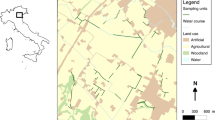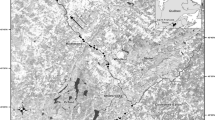Abstract
A geographic information system, fractal analyses, and statistical methods were used to examine the spatial distributions of old growth hemlock, northern hardwood, mixed hardwood/hemlock stands and wetlands with respect to each other and also soils and topography. Greater than 80% of the stands of any covertype were less than 20 ha in area. Nearly pure hemlock and northern hardwood stands were associated with soils having a fragipan, while mixed hardwood/hemlock stands were associated with sandier soils. Hemlock stands were distributed independently of hardwood and mixed hardwood/hemlock stands, but hardwood and mixed hardwood/hemlock stands were usually surrounded by hemlock. Bogs and lakes were usually surrounded by hemlock stands and are distributed independently of hardwood stands. The shapes of all stands vary from extremely simple to extremely complex, with a general tendency for hemlock stands to be more convoluted than hardwoods. The analyses suggest segregation across soil types and a disturbance regime favoring the establishment of hardwoods and mixed hardwood/hemlock stands in a hemlock matrix as reasons for the origin of the observed spatial patterns.
Similar content being viewed by others
Literature cited
Adams, M.S. and Loucks, O.L. 1971. Summer air temperatures as a factor affecting net photosynthesis and distribution of eastern hemlock [Tsuga canadensis L. (Carrierre) in southwestern Wisconsin. The American Midland Naturalist 85: 1–10
Burrough, P.A. 1986. Principles of geographic information systems for land resources assessment, Clarendon Press, Oxford.
Cline, A.C. and Spurr, S.H. 1942. The virgin upland forest of New England. Harvard Forestry Bulletin 21.
ERDAD, INC. 1987. Image Processing System User’s Guide. ERDAS, INC, Atlanta.
Frelich, L. 1986. Natural disturbance frequencies in the hemlock-hardwood forests of the Upper Great Lakes Region. Ph. D. Thesis, University of Wisconsin, Madison, Wisconsin.
Forman, R.T. and Godron, M. 1986. Landscape Ecology. John Wiley and Sons Inc. New York, 619 pp.
Goff, F.G. 1967. Upland vegetation.In: Soil Resources and Forest Ecology of Menominee County, Wisconsin. pp. 60–90. Wisconsin Geological and Natural History Survey Bulletin 85, Soil Series 60, Madison, Wisconsin.
Graham, S.A. 1941. The question of hemlock establishment. Journal of Forestry 39: 567–569.
Hix, D.M. and Barnes, B.V. 1984. Effects of clar-cutting on the vegetation and soil of an eastern hemlock dominated ecosystem, western Upper Michigan. Canadian Journal of Forest Research 14: 914–923.
Hough, A.F. and Forbes, R.D. 1943. The ecology and silvics of forests in the high plateaus of Pennsylvania. Ecological Monographs 13: 299–320.
Jacobs, J. 1974. Quantitative measurement of food selection: a modification of the forage ratio and Ivlev’s electivity index. Oecologia 14: 413–417.
Jenkins, S.H. 1979. Seasonal and year-to year differences in food selection by beavers. Oecologia 44: 112–116.
Jordan, J.K. 1973. A soil resource inventory of the Sylvania Recreation Area. USDA Forest Service, Ottawa National Forest, Watersmeet Ranger District.
Krummel, J.R., Gardner, R.H., Sugihara, G., O’Neill, R.V. and Coleman, P.R. 1987. Landscape patterns in a disturbed environment. Oikos 48: 321–324.
Lovejoy, S. 1982. Area-perimeter relation for rain and cloud areas. Science 216: 185–187.
Maissurow, E.E. 1941. The role of fire in the perpetuation of virgin forests in northern Wisconsin. Journal of Forestry 39: 201–207.
Mandelbrot, B.B. 1977. The Fractal Geometry of Nature. W.H. Freeman and Company, New York.
McIntosh, R.P. 1972. Forests of the Catskill Mountains, New York. Ecological Monographs 42: 143–161.
Miles, M.L. and Smith, E.C. 1960. A study of the origin of hemlock forests in southwestern Nova Scotia. Forestry Chronicles 36: 375–390.
Milfred, C.J., Olson, G.W., Hole, F.D., Baxter, F.P., Goff, F.G., Creed, W.A. and Stearns, F. 1967. Soil Resources and Forest Ecology of Menominee County, Wisconsin. Wisconsin Geological and Natural History Survey Bulletin 85, Soil Series 60, Madison, Wisconsin.
Oosting, H.J. and Billings, W.D. 1939. Epaho-vegetational relations in Ravenel’s Woods. The American Midland Naturalist 22: 333–350.
Oosting, H.J. and Hess, D.W. 1956. Microclimate and a relic stand of Tsuga canadensis in the lower piedmont of North Carolina. Ecology 37: 28–39.
Pastor, J., Aber, J.D., McClaugherty, C.A., and Melillo, J.M. 1984. Aboveground production and N and P cycling along a nitrogen mineralization gradient on Blackhawk Island. Wisconsin. Ecology 65: 256–268.
Spies, T.A. 1983. Classification and analysis of forest ecosystems of the Sylvania Recreation Area, Upper Michigan. Ph. D. Thesis, University of Michigan, Ann Arbor, Michigan.
Spies, T.A. and Barnes, B. 1985a. A multifactor ecological classification of the northern hardwood and conifer ecosystems of Sylvania Recreation Area, Upper Peninsula, Michigan. Can. J. For. Res. 15: 949–960.
Spies, T.A. and Barnes, B. 1985b. Ecological species groups of upland northern hardwood-hemlock forest ecosystems of the Sylvania Recreation Area, Upper Peninsula, Michigan. Can. J. For. Res. 15: 961–972.
Turner, M.G. and Ruscher, C.L. 1988. Changes in landscape patterns in Georgia, U.S.A.. Landscape Ecology 1: 241–251.
Turner, M.G., Costanza, R. and Sklar, F.H. 1989. New methods to compare spatial patterns for landscape modeling and analysis. Ecological Modelling (in press).
Author information
Authors and Affiliations
Rights and permissions
About this article
Cite this article
Pastor, J., Broschart, M. The spatial pattern of a northern conifer-hardwood landscape. Landscape Ecol 4, 55–68 (1990). https://doi.org/10.1007/BF02573951
Issue Date:
DOI: https://doi.org/10.1007/BF02573951




